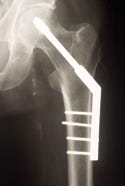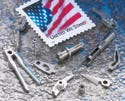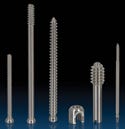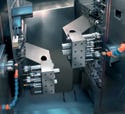Precision Technology Drives the Evolution of Orthopedic Devices
When size, time, and quality matter, orthopedics manufacturers choose precision technology.
September 1, 2007
PRECISION TECHNOLOGY
|
|
Manufacturers use thread whirling and high-pressure drilling to machine implants such as lag screws for the hip and various bone screws. (Photos courtesy of Tornos SA (Moutier, Switzerland)) |
In a rapidly changing industry, orthopedics manufacturers try to stay ahead of the competition by being the first to market the most durable and innovative products. They're recognizing the increasing demand for orthopedic devices, especially among athletes and active baby boomers who expect nothing less than products of the highest quality.
So, these days, orthopedics companies are calling for smaller and lighter products with tighter tolerances in complex geometries. To meet these detailed product requirements, they turn to precision technology.
Quick Turnaround
Precision technology manufacturers are not only required to make extremely accurate devices and components, they're also being pressured by time. Orthopedics firms want suppliers to get their products out the door as quickly as possible. Production volumes in this industry are traditionally lower than in other medical segments, and competition requires product turnaround in as little as four weeks. This means that the time from product design to launch can be as short as six months.
“Time to market is being compressed rapidly,” says Todd McKinley, vice president of operations at Miltronics & Skye (Mentor, OH). “In the past, if you could beat a 10–12-week lead time, then you could play within this market. [Now], you need to have both prototyping and production capabilities, because customers don't want to go through the development phase twice. It's not easy to do well in this market if just your toe is in the water.” Miltronics & Skye manufactures spinal implants, screws, plate systems, and instruments for the orthopedics market.
The orthopedics market can also be a challenge for smaller suppliers because of the amount of labor required. “Customers want to absorb less of the work content or manage the program themselves,” says McKinley. “Companies traditionally tend to bring in three or four suppliers at the same time on a launch, expect one or two to not succeed, and then spread the work load across multiple suppliers throughout the [product] life cycle.”
|
Tiny grippers, cutters, and laserfeed tubes are used in minimally invasive surgery. Photo courtesy of Metal-Craft Machine & Engineering (Elk River, MN). |
Also looming on the horizon is overseas competition, especially in Asia. Some firms there have potential to provide products to orthopedics companies sooner than suppliers in the United States. “We have to keep changing equipment to try to find a better way to make products faster,” says Jack Mowry, president of Metal-Craft Machine & Engineering (Elk River, MN). “Probably the only thing that keeps us from getting run over by foreign competitors like the Japanese or Koreans is the fact that we can turn around [products] faster.” North American suppliers can deliver products faster because they are closer to their customers and don't have a language barrier. However, Mowry warns, “if [others] cross some of those hurdles, then we're going to be in big trouble.”
The Cutting Edge
Orthopedic device development has grown by leaps and bounds. So, too, has precision manufacturing machine technology. And as a result, it is becoming more affordable. This is allowing more companies to enter into the market, according to McKinley. Engineers are also keeping up with the pace of equipment such as multiaxis machines. “You used to see [engineers] struggle to get 31⁄2- to 41⁄2-axis cuts. Now, the minute that a 9-, 10-, or 11-axis machine is available, engineers are quick to adapt the technology into their [product] designs,” says McKinley.
Manufacturers use multiaxis machines to perform several processes at the same time. The equipment is suitable for orthopedics. It meets the high standard of producing tight tolerances for a range of products from minimally invasive surgery instruments to devices for the spine, hips, and knees.
According to Mowry, one reason that equipment is becoming less expensive is because more companies are manufacturing Swiss-style machines than in the past. Swiss machines perform a variety of functions such as drilling, milling, and tapping to make products such as instruments and screws.
Jade Precision Medical Components LLC (Southampton, PA) uses CNC Swiss turning centers to manufacture screws, components, and devices for the orthopedics market. Stephen Keil, the company's manager of business development, says the machines are faster and have more attachments than they did five years ago. “The newer CNC machines are more rigid, which enables us to maintain closer tolerances, and the machining capabilities keep growing,” says Keil.
More-affordable and more-capable equipment is leading manufacturers to seek out different product designs in their quest to separate themselves from the competition. “Rather than having a traditional me-too design, they'll [demand] complex shapes in difficult-to-machine materials like cobalt chromes and ceramics,” says McKinley. “They're doing a lot more free-form geometries.”
As components become more complex, so do the number of machining operations required to complete them. Along with complexity, parts are becoming smaller, some sized at the micron level, as a result of new technologies and materials.
“Very small parts can also be a challenge to manufacture with respect to tight tolerances, specific cutting tools needed, size of the machine, difficulties adjusting the tools during the setup process, and difficulties manipulating the part,” says Philippe Charles. He is market segment manager of medical technology at Tornos SA (Moutier, Switzerland).
To simplify the machining of complex geometries, Tornos uses a highly graphic programming interface and in-process checking controls on its equipment. Its turning centers are designed for simultaneous machining with several tools that cut on the front and back spindles at the same time. This allows manufacturers to handle multiple machining operations more efficiently.
|
A variety of bone screws can be manufactured using thread whirling, a process that eliminates the need for secondary finishing operations. Photo provided by Tornos SA. |
When handling very small parts, air or electric high-frequency spindles in the 120,000-rpm range and quick-change tooling can be used, accompanied by a vacuum system that collects the tiny parts. An integrated handling unit within the machine also makes it easier to manipulate small components.
Thread whirling is a key turning center technology for orthopedic parts, according to Leonard Lanute, product manager at Tornos US (Brookfield, CT). The process eliminates thread cutting and tapping, and produces clean contours that are free of burrs. Equipment such as a sliding headstock-turning center can thread up to 2500 titanium parts without breakage and machine down to the bottom of very small threads or blind holes. Thread whirling is performed on the main or counter spindle at speeds of up to 30,000 rpm for internal thread cutting. Manufacturers can use this kind of machine to make dental implants with internal threads, surgical screws, screw-to-bone implants, and maxillofacial screws with external threads.
Cost and Production Efficiency
To keep costs as low as possible, many manufacturers are asking for complete parts to be made with one machine, without the requirement of an additional setup. It is important, says Keil, to “limit the amount of machining and operations done to the components because it reduces the chance for variation. Orthopedics companies are always looking for the best [process] with the least amount of handling for their components.”
Although many precision machining processes are requiring less human interaction, suppliers are always looking for ways to get the job done faster and in a more cost-effective manner.
“Right now, subcontractors of the orthopedics industry are feeling price pressure from OEMs,” says Charles. As a result, it has become more important to increase productivity by decreasing the amount of time that it takes to machine components.
“We work on a daily or weekly basis to do things better, faster, and cheaper. That's the driving force of the industry and most businesses today,” says Greg Reimer, vice president of business development at Molded Rubber and Plastic Corp. (Butler, WI). “Being a contract manufacturer, we work with a lot of different customers that have a lot of different requirements. Anytime we can justify the investment in some automation to drive cost out of the product, we are aggressive in doing so.”
|
Tornos's Sigma 20 sliding headstock machine is equipped with an array of turning, end drilling, and live tools. Its six linear axes and 22 tooling positions provide orthopedics manufacturers with flexibility when machining complex components. |
In addition to taking advantage of automation, companies should try to make the most out of the machining technology that they are currently using. “The machines, from a programming standpoint, are highly capable, but the technology hasn't been fully explored by everyone,” says McKinley. “There are a lot of bells and whistles that aren't getting used.” He attributes part of the problem to the lack of process engineers who know how to use the new technologies in the best way.
“The equipment is advancing, and the cost point of the machines is such that more people can afford to get them, so there are more people with high-technology machines that are struggling to find people to run them,” says McKinley. “A lot of college programs produce good programmers who are good at creating code for the machines but are not machinists.”
There are several ways to improve precision machining productivity, says Charles. Manufacturers can use equipment that is dedicated to making complete parts without secondary operations and provide the peripherals needed to machine, measure, handle, and clean parts. New cutting tools will improve cutting speeds and the machining process. Optimizing part programs via software can reduce the setup and idle times of a machine. Companies should also consider developing new machine attachments that are dedicated to specific product needs.
Difficult-to-Machine Materials
The demand for high-quality implants and components made with the most resilient materials remains a constant in orthopedics. As a result, manufacturers strive to improve machining techniques, and the introduction of different materials will further drive a need for advanced processes.
“Ten years ago, we heard that solutions for orthopedics would be biologic [and] that in the near future, there would be no metals like titanium [and] stainless steels, [or] plastics used anymore,” says Charles. “But today we are still using these materials, and we still need to optimize their machining processes.”
|
Tornos's Sigma 20 single-spindle sliding headstock machine performs main operations on the right side as the left side simultaneously conducts counter operations. Both sides are completely independent from each other. |
Metal-Craft deals with materials that are difficult to machine by applying coatings to its cutting tools to keep the wear down. The company also uses machines that have more revolutions per minute and smaller cutters to accommodate smaller part sizes.
Cobalt chrome is a strong metal alloy that is used in hip, knee, and spinal implants for its wear resistance. Manufacturers might find it challenging to machine cobalt chrome, because the alloy is as hard as or harder than some of the tools that are being used to cut the material. The material also requires the use of high-speed tooling with a tight focus on the cooling of the product.
“For companies that are only working with stainless [steel] or titanium, cobalt chrome might be a leap,” says McKinley. “There's not as much readily available industry knowledge on how you approach those parts, so it's a lot of trial and error. Someone who's only been traditionally working with stainless [steel] and titanium in the [orthopedics] market will really struggle to make the leap from those alloys into the cobalt chrome applications.”
Titanium is commonly used in orthopedic products because of its low weight and inertia with other elements. However, manufacturers face challenges when using titanium. Parts must meet precise dimensional tolerances and have exceptional surface quality, and because titanium is prone to burrs, it is difficult to machine.
Polyetheretherketone (PEEK) is increasing in popularity as an alternative to titanium in implants. The radiolucent material offers strength and wear resistance, so it can be imaged with technology such as x-rays and magnetic resonance imaging. When machining it, however, operators must take care that cracks don't form during cutting or that too much heat is created. “PEEK is also a different application in which you need dedicated resources and a dedicated space with stringent cleanliness requirements,” says McKinley.
The quest for longer-lasting, biocompatible implants will usher in the development of new materials, require the alteration of existing materials, and lead to different machining techniques. “All these changes will need specific adaptations of the machining technologies or machines themselves,” says Charles. “This is also where machine-tool manufacturers have to do fine-tuning to be able to monitor the market needs and be ready to offer the best solutions in the future.”
The Future Emerges
The future of precision technology in the orthopedics industry is unlimited and promising. The introduction of microelectromechanical systems (MEMS) in implants could change the shapes of components and how they're machined. MEMS would aid in monitoring how implants are being used, along with enhancing bone fusion via electrical pulses.
Mowry foresees the molecule-by-molecule assembly of components. Molecules would be fed into a machine and, through chemistry and electronics, the machine would be able to manufacture the desired component. Because parts are made out of molecules, accuracy would go beyond 1 µm. Component accuracy would be nearly perfect, says Mowry.
|
Laser deposition technology makes complex orthopedic implants more precise by building an implant in layers and machining a part as it is being formed. Photo courtesy of Purdue University (West Lafayette, IN). |
The process, called stereolithography, is already used with plastics to make handsets on phones, for example. “It's going to be a long time before it's cost-effective enough to do it on a high-volume basis, but it'll definitely be there for prototyping and extreme accuracy in testing,” says Mowry. “It'll be years before it can be done on a competitive basis, but it'll happen.”
In the same vein, researchers at Purdue University (West Lafayette, IN) have developed a patent-pending laser deposition technology that can be used to manufacture complex orthopedic implants. While laser deposition isn't a new manufacturing method, the machining step added by Purdue researchers increases the accuracy of the technique.
The process can be used to machine components or implants with any kind of geometry with features made of materials such as stainless steel, titanium, and ceramics. That includes internal features, such as a channel in an implant that allows for fluid circulation.
The part or implant is built in layers, melted with a laser, and then immediately machined. The part is machined as it is being formed, so manufacturers can create shapes that are 20 times more precise.
“We're combining deposition with the machining process at the same time,” says Yung Shin, PhD, professor of mechanical engineering at Purdue. “Typical current deposition processes produce parts that are very rough, about 20 µm in surface finishing. We can produce parts with surface finishing accuracy under 1 µm. That will meet the requirements of most biomedical implants.”
Conclusion
Precision technology plays a crucial role in driving the evolution of orthopedic products. As the technology continues to advance and develop more capabilities, engineers will be able to push the boundaries of device innovation even further.
“When you think about it, the engineers and designers see what's out there and how capable the equipment is, and it gives them an unlimited design,” says Mowry.
Copyright ©2007 Medical Device & Diagnostic Industry
About the Author(s)
You May Also Like









